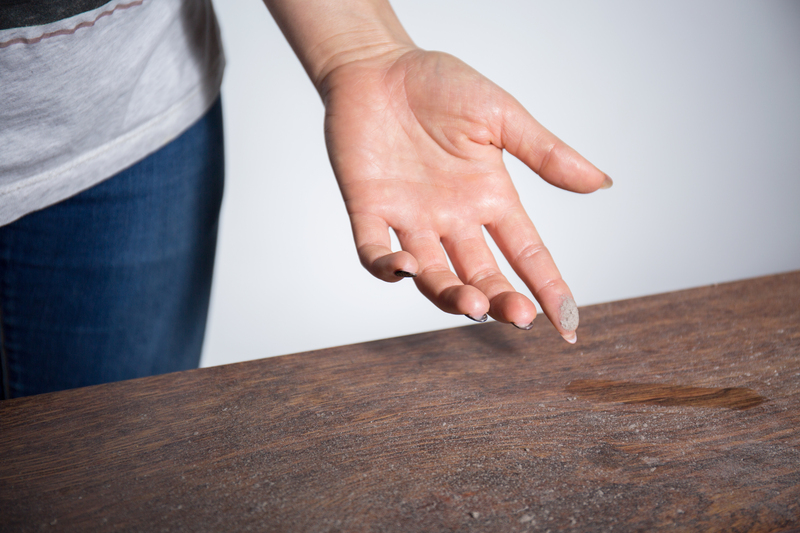Maintaining Fresh Curtains: A Simple and Effective Guide
Posted on 29/08/2025
Maintaining Fresh Curtains: A Simple and Effective Guide
Curtains not only enhance the visual appeal of your rooms but also help regulate sunlight, preserve privacy, and contribute to a cozy ambiance. However, without proper care, they can trap dust, odors, and allergens, undermining their beauty and functionality. This comprehensive guide will walk you through every step of maintaining fresh curtains, ensuring your home always looks, feels, and smells inviting.
Why Curtain Freshness Matters
Fresh curtains are more than just a design statement. They play a crucial role in your overall indoor environment. Here's why keeping your curtains clean and vibrant matters:
- Air Quality: Curtains act as filters, trapping dust, pet dander, and airborne pollutants which, if not cleaned regularly, can adversely affect your indoor air quality.
- Allergen Control: For households with allergy sufferers, fresh drapes and curtains can minimize triggers and improve health.
- Lifespan: Regular maintenance prolongs fabric life, keeping your curtains functional and beautiful for many years.
- Odor Prevention: Curtains can absorb kitchen fumes, smoke, and other household odors. Fresh curtains naturally eliminate musty or unpleasant smells.
- Aesthetic Appeal: Clean, vibrant curtains instantly lift the look of any room.

Understanding Different Curtain Fabrics
The method for caring for your curtains largely depends on their fabric type. Different materials require specific maintenance to retain their freshness and integrity. Here's a quick breakdown:
Cotton Curtains
- Easy to wash and maintain.
- Can usually be machine-washed unless indicated otherwise.
- May require ironing to maintain crispness.
Linen Drapes
- Natural and breathable but can wrinkle easily.
- Gentle hand-washing or dry-cleaning preferred for long-term freshness.
Silk Curtains
- Luxurious, delicate, and susceptible to sun damage and water spotting.
- Require professional (dry-cleaning) handling for ultimate care.
Synthetic Fabrics (Polyester, Acrylic)
- Durable and resistant to wrinkles and shrinking.
- Generally machine-washable and easy to maintain.
Velvet Curtains
- Elegant but attract dust quickly.
- Need regular gentle vacuuming or professional cleaning to stay fresh.
Always check the care label before beginning any cleaning process to maintain curtain freshness and prevent accidental damage.
Routine Care for Maintaining Fresh Curtains
Maintaining fresh curtains starts with regular, simple routines. Here are the best practices you can adopt to prolong curtain freshness between deeper cleans:
1. Weekly Dusting or Vacuuming
- Use the soft brush attachment on your vacuum cleaner to gently remove dust, pollen, and pet hair.
- Vacuum in vertical strokes, starting at the top and moving downward.
- For delicate or embroidered curtains, consider a lint roller or gentle fabric brush instead.
2. Spot-Cleaning Stains
- As soon as a stain appears, blot (never rub) it with a clean damp cloth.
- Test cleaning solutions on an inconspicuous area first to prevent discoloration.
- For food, wine, or ink stains, a mix of mild detergent and cool water usually works.
3. Shaking Out Curtains
- Give your curtains a quick shake every few days when opening windows.
- This simple act helps dislodge dust and debris, keeping them looking newly hung.
Deep Cleaning Curtains for Long-Lasting Freshness
Even with routine care, curtains benefit from a deep clean several times a year. Here's how to keep curtains fresh with a thorough wash or clean:
Machine Washing Curtains
- Remove all hooks, rings, and tie-backs.
- Choose a gentle cycle with cold or lukewarm water.
- Select mild detergent designed for delicates or the specific fabric type.
- Do not overload your washing machine to prevent wrinkling or tearing.
- After washing, hang the curtains immediately to dry to minimize wrinkles. If possible, dry them outside on a sunny, breezy day for a natural freshness boost.
Hand Washing Delicate or Embellished Curtains
- Fill a large sink or tub with lukewarm water and add a small amount of mild detergent.
- Submerge the curtains and gently agitate with your hands to loosen dirt.
- Rinse thoroughly with clean, cool water.
- Press out excess water gently, don't wring. Lay flat or hang to dry.
Dry Cleaning for Specialty Fabrics
- Fabrics such as silk or those with intricate designs almost always require professional cleaning.
- Read the label first; "dry-clean only" means home washing can result in shrinkage, color fading, or warping.
- Try to dry-clean these curtains at least once a year, or more if exposed to smoke, heavy cooking, or dust.
Curtain Maintenance Tips for Different Home Spaces
*The freshness of your curtains often depends on the environment of each room. Tailoring your curtain maintenance routine to the specific area will ensure consistent results throughout your home:*
Living Room Curtain Care
- Sun exposure can fade colors, so consider lining curtains or using sheer panels to minimize damage.
- Rotate and switch between different curtain sets to even out wear and fading.
- Vacuum at least once a week for dust removal.
Kitchen Curtains
- More prone to stains and odors due to cooking fumes. Choose machine-washable, easy-care fabrics.
- Wash every 1-2 months or as needed, especially if you cook daily.
- Avoid heavy, absorbent materials that trap grease and moisture.
Bedroom Curtains
- Bedrooms benefit from dust- and allergen-free curtains. Regular vacuuming and washing (every 3-6 months) is ideal.
- Consider blackout or thermal curtains to boost sleep quality and temperature control.
Bathroom Curtains
- Steamy environments can encourage mold and mildew on fabric curtains.
- Wash frequently and ensure good ventilation.
- For shower curtains, wipe down after use or choose quick-dry, mildew-resistant fabrics.
Methods to Keep Curtains Fresh Between Washings
Maintaining fresh curtains isn't just about cleaning--it's also about prevention between washes. Here are strategies to retain that just-laundered feeling:
- Spritz with Fabric Fresheners: Use gentle, fabric-safe sprays to neutralize odors.
- Open Windows Regularly: Air circulation helps prevent mustiness and keeps curtains fresh.
- Use Essential Oils: Lightly mist curtains with diluted essential oils for a natural, refreshing fragrance (lavender and lemon are great choices).
- Baking Soda: Occasionally sprinkle a bit of baking soda on the fabric to neutralize odors, then vacuum it off after 20 minutes.
- Dehumidifiers: In damp environments, a dehumidifier prevents mold and mildew buildup.
- Sunlight: Hang curtains in the sun (if fabric allows) for a few hours to kill bacteria and freshen naturally.
Dealing With Stubborn Curtain Odors
Over time, curtains may develop lingering odors from smoke, pets, or spills. Here's how to restore their freshness:
- Air Out: Remove curtains and hang them outdoors for several hours on a dry, bright day.
- Steam Clean: A handheld steam cleaner is safe for many fabrics and can remove odors and sanitize simultaneously.
- White Vinegar Spray: Mix equal parts vinegar and water in a spray bottle and lightly mist the curtains. The vinegar odor dissipates as it dries, taking unpleasant smells with it.
- Scented Dryer Sheets: Rub a dryer sheet over the surface or pin one discreetly behind the curtain; just be sure to test for any discoloration first.
When to Replace Your Curtains
No matter how diligent you are, every curtain set has a shelf life. Knowing when to refresh or replace them is key to maintaining your home's freshness.
- Persistent staining or discoloration that resists cleaning is a sign it's time for new curtains.
- Fabric tears, thinning, or fraying can diminish both function and aesthetics.
- Lingering odors even after multiple washes may indicate hidden mildew or fabric breakdown.
- Updating decor? New curtains offer an easy and effective room makeover.
Curtain Storage Tips for Ongoing Freshness
If you rotate curtains seasonally or keep extra sets, proper storage keeps them fresh and ready to use:
- Clean and thoroughly dry curtains before storing to prevent mildew.
- Store in breathable fabric bags or pillowcases, not airtight plastic, to allow fabrics to breathe.
- Add a sachet of dried lavender or cedar chips to natural ward off pests and odors.
- Avoid folding along the same lines repeatedly to minimize creases.

Frequently Asked Questions (FAQ) About Curtain Freshness
How often should I clean my curtains?
*It depends on their location and exposure but, in general, vacuum or dust weekly, spot-clean as needed, and wash or dry-clean every 3-6 months.*
Can I wash all curtains in a machine?
*Most lightweight, non-lined, synthetic or cotton curtains can be machine-washed, but always check care labels. Delicate, lined, or specialty fabrics require hand-washing or professional cleaning.*
What's the best way to freshen curtains without washing them?
*Regular vacuuming, sunning, spritzing with fabric sprays, and the use of essential oils or baking soda help maintain curtain freshness between washes.*
Conclusion: Enjoying Fresh Curtains Year-Round
Maintaining fresh curtains doesn't have to be time-consuming or difficult. By following the guidance shared here--understanding your fabric type, sticking to a routine cleaning schedule, and addressing stains or odors promptly--you can keep your home looking, smelling, and feeling its best. Remember, fresh drapes and curtains are a small luxury that make a big difference in your daily comfort and your home's atmosphere. Set a reminder, incorporate these easy steps, and revel in the freshness of your beautiful curtains all year round!




